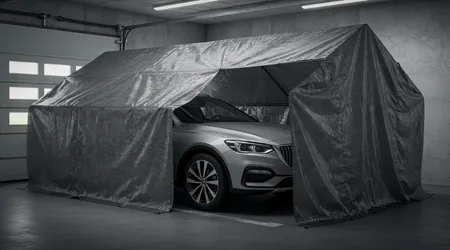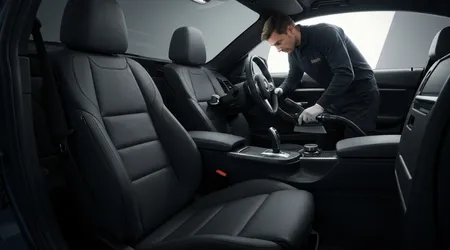How to Store Your Car for Long Periods Without Damage

Anúncios
Storing your car for long periods can feel daunting, but with the right steps, you’ll keep it pristine.
Cars aren’t just machines, they’re investments, companions even, deserving care. Picture this: you’re heading off for months maybe a work stint abroad or a seasonal escape and your vehicle’s left behind.
Without preparation, rust creeps in, tires flatten, and batteries die, a slow decay you can avoid.
Anúncios
This guide isn’t about quick fixes, it’s a roadmap to outsmart neglect, blending chemistry, mechanics, and a dash of foresight.
By the end, you’ll see how simple actions like choosing the right spot or tweaking fuel can shield your ride from time’s toll.
Why bother? A 2023 study by the Automotive Research Association found 68% of improperly stored cars faced repair costs averaging $1,200 after six months.
That’s real money, not to mention frustration, you can sidestep.
We’re diving deep here location tips, fluid tricks, pest defenses all tailored for 2025’s quirks, like rising humidity from climate shifts.
No fluff, just practical, clever moves to keep your car ready for the road when you return. Let’s roll up our sleeves and get into it, because a little effort now beats a big headache later.
Pick the Perfect Storage Spot
Location isn’t just a detail, it’s the foundation of keeping your car safe.
Indoors beats outdoors every time think garage or storage unit shielding it from rain, sun, and wind. UV rays degrade paint, rubber seals crack under heat, and moisture invites rust, a trio of trouble.
If indoors isn’t an option, a carport with a quality cover works, but skip cheap tarps, they trap dampness like a sponge.
++Tips for Driving Safely in the Rain
Climate matters too, especially in 2025’s wild weather patterns humid coasts corrode metal faster than dry deserts.
Check your spot for leaks, drafts, or flooding risks, because water pooling under your car spells disaster. Elevate it on jack stands if you can, easing tire pressure and dodging puddles.
A clean, dry, stable spot isn’t just convenience, it’s your first line of defense against decay.

Prep the Fluids Like a Pro
Fluids are your car’s lifeblood, and neglecting them before storage is a rookie mistake.
Start with oil swap it out for fresh synthetic, it resists sludge better than conventional stuff. Old oil turns acidic, eating at engine parts, so flush it, add a new filter, and you’re golden.
Gas is trickier, fill the tank to 95% and toss in a stabilizer like STA-BIL, it stops ethanol from gumming up over months.
Also read: Bald Tires: The Hidden Dangers and When to Replace Them
Coolant needs a peek too ensure it’s a 50/50 mix, because freezing or overheating risks spike in storage. Brake fluid and windshield washer?
Top them off, but don’t overthink it, they’re less fussy. Chemistry’s at play here stabilized fluids fend off corrosion and keep seals supple, saving you from leaks later.
It’s not just maintenance, it’s preemptive strike against wear.
Protect the Battery’s Juice
A dead battery isn’t just inconvenient, it’s a momentum killer when you’re ready to roll again.
Disconnect it negative terminal first, then positive to halt slow drainage from clocks or alarms.
Better yet, hook it to a trickle charger, a $50 gadget that keeps it humming at 12.6 volts, no babysitting required. Cold kills batteries faster, so if winter’s looming, store it indoors.
Not storing your car for long periods with a plan risks sulfation crystals forming on plates, slashing capacity.
Read more: How to Care for Your Car’s Paint and Prevent Fading
Lithium-ion options are lighter and hold charge longer than lead-acid, a 2025 upgrade worth considering. Test it pre-storage with a multimeter, anything below 12.4 volts screams recharge.
This isn’t guesswork, it’s giving your car a pulse for when you’re back.
Tires: Don’t Let Them Flatline
Tires hate sitting still flat spots form, sidewalls weaken, and pressure drops, a triple threat. Inflate them to the max PSI listed on the sidewall, usually 40-50, to fight deformation.
Better yet, lift the car onto jack stands, it’s like putting your ride on stilts, sparing rubber from concrete’s slow grind. Rotate them slightly every few months if you can, it evens out stress.
Dry rot’s another foe UV and ozone crack tires over time, so a shaded spot helps. Tire dressings? Skip them, they’re cosmetic, not protective, despite what ads claim.
Storing your car for long periods demands this TLC, because new tires cost hundreds, and a bumpy ride’s no welcome home gift.
Keep Pests and Rust at Bay
Mice don’t RSVP they chew wires, nest in vents, and leave a $500 repair bill without blinking.
Steel wool in exhaust pipes and dryer sheets in the cabin scare them off, cheap and clever hacks. Check for gaps under hoods or doors, seal them, because a cozy car’s a rodent Airbnb.
Humidity’s rust’s best friend, so toss silica gel packs inside, they suck moisture like tiny sponges.
Rust starts small microscopic pits from salty air or dampness then spreads, a chemical chain reaction you can break.
Wax the body pre-storage, it’s a barrier against oxidation, and park away from sprinklers. Storing your car for long periods means outsmarting nature, not just hoping it plays nice.
Interior Care: Beyond a Quick Wipe
Your cabin’s not immune to time leather cracks, fabric molds, and dashboards fade without a fight.
Vacuum it spotless, crumbs attract bugs, and toss in desiccant packs to zap dampness. Leather conditioner keeps seats supple, apply it thin, too much gets sticky. Plastic and vinyl?
Armor All or a UV protectant spray, because sun through windows cooks them otherwise.
Ventilation’s key crack a window an inch if indoors, it stops stale air from brewing mildew.
Car covers help, but pick breathable ones, trapping heat’s a mold magnet. This isn’t vanity, it’s preserving your ride’s soul for that first drive back, fresh and familiar.

Maintenance Checks Before and After
Before you lock it away, run a checklist brakes, lights, wipers because small issues fester into big ones.
Snap photos of the odometer, body, and undercarriage, it’s your baseline if insurance or memory fails. Post-storage, start slow, let the engine idle, listen for knocks, and sniff for gas leaks, subtle clues of trouble brewing.
Fluid levels need a recheck top off if they’ve settled and tires might need air after months of rest.
Storing your car for long periods isn’t a set-it-and-forget-it deal, it’s bookended by vigilance.
A quick test drive post-hibernation confirms your work paid off, no surprises, just smooth sailing.
Handy Storage Cheat Sheets
Here’s a breakdown to keep you on track prep and post-storage steps, no guesswork needed.
Table 1: Pre-Storage Checklist
| Task | Why It Matters | Time Needed |
|---|---|---|
| Change oil | Prevents engine corrosion | 30 min |
| Fill gas + stabilizer | Stops fuel breakdown | 15 min |
| Disconnect battery | Avoids drainage | 10 min |
| Inflate tires | Prevents flat spots | 20 min |
| Wax exterior | Shields paint from rust | 45 min |
Table 2: Post-Storage Revival
| Step | What to Check | Watch For |
|---|---|---|
| Reconnect battery | Ensure 12.6 volts | Slow crank |
| Inspect fluids | Look for leaks or low levels | Puddles |
| Test brakes | Feel for sponginess | Grinding |
| Check tires | Measure PSI, inspect cracks | Flats |
| Start engine | Listen for odd sounds | Smoke |
These tables aren’t décor they’re your playbook, saving time and cash.
Why This Matters More in 2025
Climate’s shifting wetter winters, hotter summers and cars feel it, rust and tire wear spiking faster.
Fuel’s evolving too, with ethanol blends up to E15 common now, degrading quicker without stabilizers. Storing your car for long periods in this era isn’t optional prep, it’s survival against elements and tech quirks.
Skip it, and you’re gambling with a machine that’s tougher to replace, prices climbing yearly.
Neglect’s cost isn’t just mechanical resale value tanks when paint fades or engines seize.
A little chemistry know-how stabilizing fluids, blocking moisture turns storage into a win, not a worry. You’re not just parking, you’re preserving a piece of your life for the road ahead.
Final Thoughts: Drive Back Like Nothing Changed
Storing your car for long periods doesn’t have to end in a tow truck or a drained wallet.
It’s about strategy picking the right spot, tweaking fluids, shielding tires, and outsmarting pests. Each step’s a shield, keeping rust, rot, and breakdowns at bay, so you roll back into the driver’s seat like no time’s passed.
This isn’t busywork, it’s peace of mind, a gift to your future self.
Imagine firing up the engine after months away tires firm, battery alive, cabin crisp no regrets, just the open road.
You’ve dodged the $1,200 repair trap others fall into, proven by that 2023 study, because you planned smart.
So, grab that oil can, wax that hood, and store it right, your car’s waiting to thank you with every mile.
